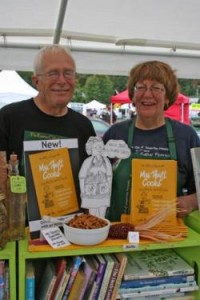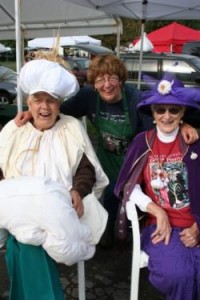“Putting food by” was a familiar term to our mothers and grandmothers. They knew September and October were harvest months, the time to preserve fruits, vegetables and herbs for use during winter and early spring. They may not have all done it, but they all knew the traditional activities that came with the end of summer– canning, pickling, jelly-making, drying and freezing.
In the last few decades, the boundaries between the seasons have blurred almost to the point of vanishing, along with many of the activities that came with the end of summer and beginning of fall. It’s a little different this year. A combination of concerns about our flagging economy, global warming and food-born illnesses caused record numbers of families to plant vegetable and herb gardens. Farmers markets are opening up all over the country. Once again, there are picture-perfect locally grown fruits, vegetables and herbs available for us to put by for winter use.
When the children were little and the vegetable garden large, I canned, pickled and froze everything I could. I proudly served our own vegetables, applesauce, pickles and condiments for most of the winter. The freezing and canning gradually ended as the children and business matured, but I have never stopped making herb butters, vinegars, pestos, jellies and mustards. They are all simple to make, take little time to do, are easy to store and last for a long time. Most importantly, they all add huge amounts of flavor to everyday meals– breakfast, lunch and dinner.
Whether you grow your own or buy from your local farmer, these two months are the time to try your hand at creating some of your own food products for your winter table. Do it. It’s easy, fun and delicious!
——————————————————————————
Each of the following recipes takes no more then 15 minutes to make, once you have ingredients and equipment assembled.
HERB VINEGAR : Push 8 to 10 stems of a favorite culinary herb or herbs–basil, thyme, parsley, sage, mint, tarragon, savory, marjoram, chives, dill—into a glass jar with a screw-top lid. Add a peeled clove of garlic. Fill the jar with red wine, white balsamic, white wine or rice wine vinegar. Screw on the lid. Store in a cupboard for two weeks. Strain, rebottle and enjoy.
HERB BUTTER: Leave a pound of butter on the kitchen counter for a few hours to soften. When it is soft enough to mix with a fork or hand-held electric beater, unwrap the sticks and put them in a bowl. Mince 3-4 tablespoons of your favorite herb or herbs–parsley, chives, basil etc. Sprinkle the chopped herbs over the butter. Press one clove of peeled garlic and add to the butter. Squeeze 1/4 of a lemon over the butter. Mix everything together with a fork or small electric mixer. Pack into plastic containers with snap-on lids and store in the freezer.
HERB MUSTARD: Buy a large bottle of your favorite mustard. Scrape the mustard into a bowl. Finely chop one or two cloves of peeled garlic. Stir the garlic into the mustard. Mince 1 1/2 to 2 tablespoons of a favorite herb or combination of herbs. Stir them into the mustard. Pack the mustard back into it’s bottle. Store in the refrigerator. Allow a week or two for flavors to blend. Use and enjoy.
PESTO: “Pesto” doesn’t mean basil. The word comes from the pestle used to pound savory green leaves, cheese and olive oil into a sauce in a mortar. Our modern blenders and food processors give the same results, but we still call the sauce “pesto”.
Pesto is easy to make and keeps well in the freezer or refrigerator. It is a delicious way to preserve the flavor of freshly picked herbs for winter use. The master recipe for pesto is 2 cups of herb leaf, 1/2 cup cheese, 1/2 cup olive oil, 2 cloves peeled garlic and 1/4 cup nuts.
The classic basil recipe uses: 2 cups fresh basil leaves, 1/2 cup freshly grated parmesan or romano cheese, 1/4 cup pine or walnuts, 1/2 cup olive oil, 2 cloves peeled garlic , salt, and pepper. Reduce the ingredients to a sauce in a blender or food processor, Pack the pesto into a 1/2 pint canning jar or plastic container with a snap-on lid. Store in the freezer or refrigerator and enjoy with pasta and soups all winter.
Parsley, mint, sage, thyme and cilantro are all delicious made into pesto. Use two cups of parsley leaves for the parsley pesto. For all the others use 1 cup of parsley leaves to 1 cup sage, mint, thyme or cilantro leaves. Walnuts are as delicious as pine nuts but are more economical and available.
One last pesto thought: Try slathering pesto under the skin of chicken or turkey before it goes into the oven. Delicious!
THIS SEASON IN THE GARDEN
* October is garlic ( Allium sativum) planting season. Much of the garlic we eat today comes all the way from China. Local, home grown garlic tastes just as good and is definitely fresher.
There are two varieties of garlic, hard-necked and soft-necked. Soft-neck garlic has larger cloves and grows in warm climates, such as southern California and China. Hard-necked garlic has slightly smaller cloves and thrives in cold places, such as northern Europe, Russia and New England.
Hard-necked or cold-climate garlic is planted in October and harvested the following July or August. Many New England farms are now growing hard-necked garlic, so look for heads at farmer’s markets and farm stands. You can identify hard-neck garlic by pushing the top of the head with your index finger. Hard-neck garlic feels as if there is a stick in the center of the head. Soft-neck garlic doesn’t have a stiff center stem.
To plant garlic for your own crop, separate the heads into cloves. Do not peel the cloves. Select a dozen or so of the largest cloves. Plant the cloves, root end down, about 6-8 inches apart, in a sunny, well-drained spot in your vegetable garden. All alliums thrive in rich soil, so it is a good idea to enrich your garlic planting area with a bag or two of compost or manure before you plant.
If you love garlic and harvest festivals plan to go to one of the two big garlic festivals that take place every year in our region. The Hudson Valley Garlic Festival is held in Saugerties, New York on September 26 and 27.
The North Quabbin Garlic and Arts Festival is held in Orange, Mass. on Oct. 4 and 5. Enjoy the delicious food, country music, many vendors and be sure to buy some hard-necked garlic so you can grow your very own!
Questions, comments or suggestions? Call or email me. I’d love to hear from you! 978-475-2540. email Betsy@betsywilliams.com


